City trip Valencia
From old city gates and churches to futuristic museums
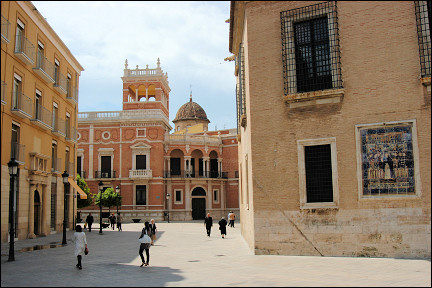
|
Valencia is a city bursting with highlights: from the churches, towers and city gates to the bullfight arena, indoor market and botanical garden. The weekly water courts still meet, after a thousand years of doing so. But Valencia also is a lively city with city beaches, an exciting nightlife and futuristic museums in the City of Art and Science.
Travelogue & photos: Mariet Arts
At the airport Manises west of Valencia we board a green bus which takes us to the city center of Valencia. We get off at Estación del Norte, the last stop.
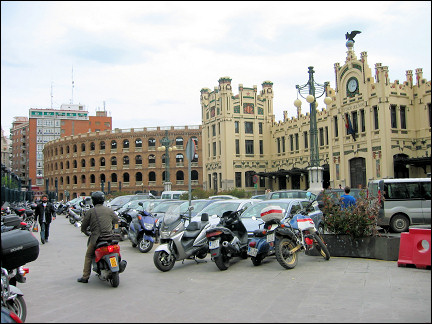
|
Next to the train station is the Plaza de Toros, the bullfight arena, a large, round neo-Classical structure. We walk to the nearby Plaza del Ayuntamiento, where our hotel is.
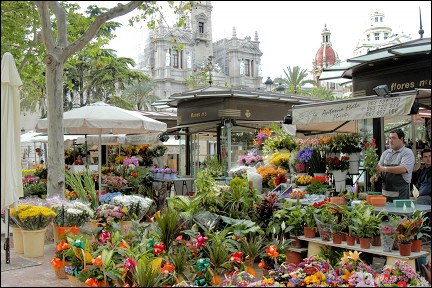
|
On the square we stop between many flower stalls and waving palmtrees. Gorgeous buildings with Baroque decorations vie for our attention: La Oficina de Correos, the post office, and El Ayuntamiento, city hall.
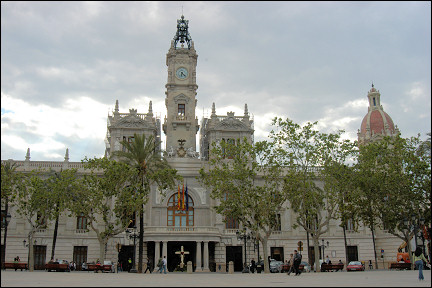
|
A little farther, next to the fountain, is the Rialto building which houses a theater, movie theater and concert hall.
We enter our hotel, check in and receive a map of Valencia, which we use immediately.
Ciutat Vella
Every entrance to the cathedral a different architectural style
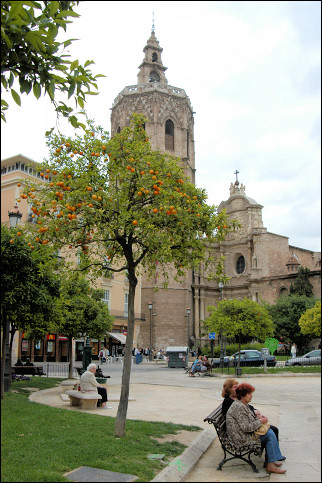
|
We stay in the old city, Ciutat Vella, in the La Seu district. On Plaza de la Reina are benches on which elderly people sit and rest; on the other side are horse carriages with which one can take a tour of the city.
We walk under the orange trees to the Catedral de Santa María de Valencia. This cathedral was built in the 13nd and 14th centuries in different architectural styles: Roman, Gothic and Renaissance.
The cathedral has three entrances: the Puerta de los Apóstoles on the Plaza de la Virgen, Puerta del Palau on Plaza de La Almoina and Puerto Hierros, the main entrance next to the belltower El Micalet on Plaza de la Reina.
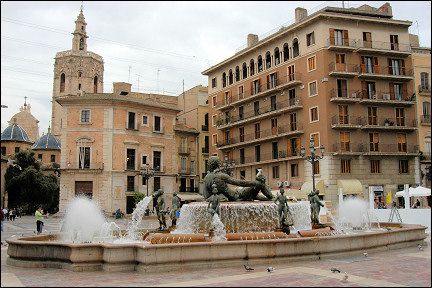
|
The belltower is over fifty meters tall and is accessible via narrow stairs from the cathedral, which lead all the way up to the top of the tower. We turn left and walk around the cathedral through an alley, El Calle del Micalet. Halfway, a street musician sits strumming his guitar.
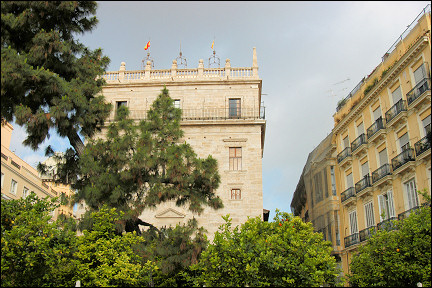
|
We arrive at Plaza de la Virgen. At the center of the square is a splashing fountain with the Greek god of the sea, Poseidon, lying down, surrounded by goddesses on pedestals with the names of irrigation canals, huertas, outside Valencia. On one side of the square are restaurants with pleasant terraces.
On the square also sits the basilica of Nuestra Señora de los Desamparados, patron saint of the city of Valencia. It is connected to the cathedral by an arch.
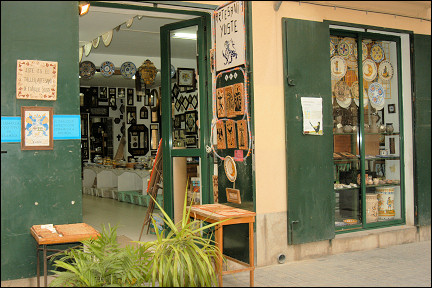
|
From the square we see the tower of the Gothic building Palacio de la Generalidad, currently the seat of the Valencia provincial government.
We wander through the streets of the old district El Carmen. On Plaza del Miracle del Mocadoret we visit Artesania Yuste. Enrique doesn't mind posing for a picture behind his workbench, but "no trabajo." He has already tiedied up and thinks it's too late to make something. We leave his studio with two hand-made azulejos, tiles with pictures of a pintor and a panadero, a painter and a baker.
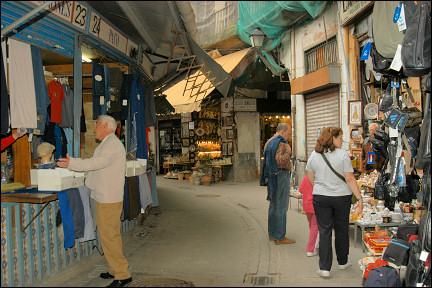
|
Plaza Redonda, a round square, the most remarkable of Valencia, has a fountain at its center and around it are all kinds of shops with curiosa and traditional products from Valencia and surroundings.
In the embroidery and lace store Pily y Amparin, one of the sales ladies shows me Spanish embroidery, which is also called Spanish lace, a splendid piece of work, embroidered with gold thread. This kind of embroidery was often used in the Renaissance.
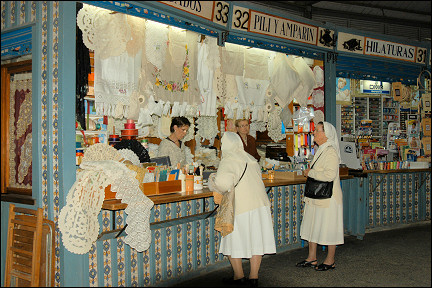
|
In café and bar Negrito on the square of the same name, young people sit at tables and drink beer, and of course we are happy to join them. Back on Plaza de la Reina, in one of the restaurants, we order tapas: deep-friend gambas, squid rings and sardines in garlic oil.
Ciudad de las Artes y las Ciencias
Some buildings look like giant spaceships
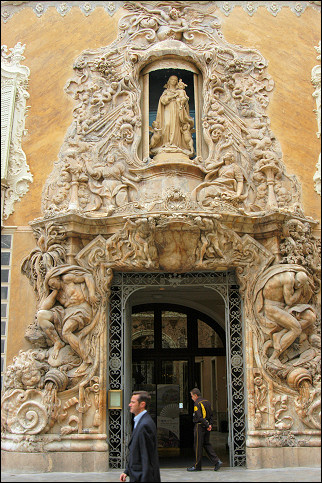
|
Next morning we leave early because, not far from the city center, a whole new world is waiting to be discovered: the futuristic Ciudad de las Artes y las Ciencias, the City of Art and Science.
From Plaza del Ayuntamiento we walk to Calle Poeta Querol. We pass the fancy store of the Lladró brothers, who began making figurines in 1953.
The china figurines from the Lladró company, whose studios and workshops are just outside Valencia, are world famous. I notice that they have changed over the last years: they have become more contemporary.
A little farther is the 15th century Palacio del Marqués de Dos Aguas, which houses the national ceramics museum González Martí.
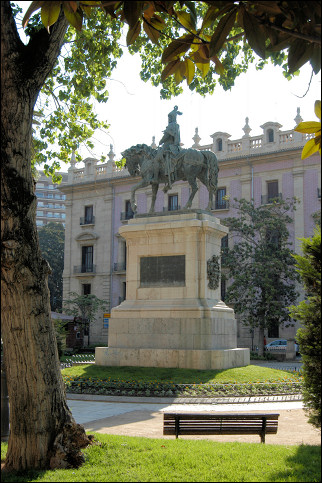
|
The most important of the exhibited objects are a collection of Valencian ceramics and tiles, a unique collection of Celto-Iberian earthenware and some works by Picasso. In the portal we see Mary with child, surrounded by angels.
We get confused by the streetnames, which are written on the buildings both in Castillano and Catalan. The strong, intoxicating scent in the street is caused by the purple-white blossoms of many trees.
In the tourist information office at the end of Calle la Paz we find lots of interesting brochures about Valencia. We read them on a bench on Plaza de Alfonso el Magnánimo (Alphons the Magnanimous). The King of Aragon sits on his horse high above us and points with his hand to something in the distance.
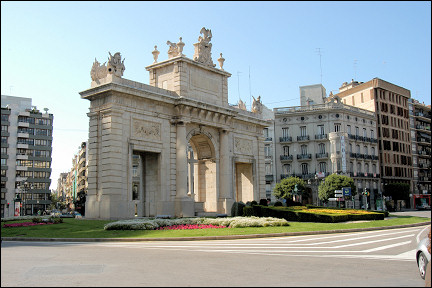
|
Libreria Paris-Valencia on the square just opens its doors and I can't keep myself from entering the bookstore. Except for books in Castillano (the official Spanish language) it also has books in Valencian.
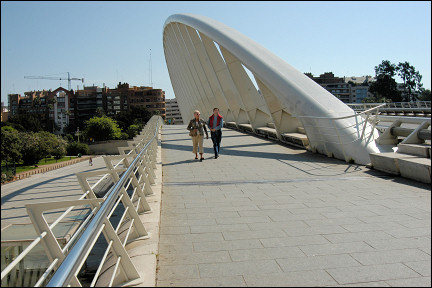
|
We leave with two Spanish books and walk via the beautiful city gate on Plaza Puerta de la Mar to Puente Calatrava, a bridge named for the architect Santiago Calatrava, who designed the new transportation hub which is being built at Ground Zero in New York.
Many Valencians nickname the bridge La Peineta, which means comb, because the bridge looks like the traditional decorative comb Spanish ladies wear in their hair.
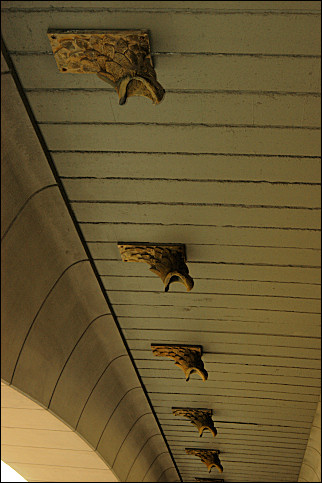
|
At the entrance to the bridge we descend a stairway to the river bed, in which the Turia used to flow. Now it's called El Jardín del Turía, the Turia Garden. After several bad floods in the 1960s, the river was diverted to the west side of the city.
We walk southward and get increasingly enthusiastic. It's almost surreal to walk in a dry river for 12 kilometers. At every bridge over the Turia are roads or steep stairs to climb up, back into the city.
Under one of the bridges hang gold-painted birdheads with open beaks, which allow the water on the bridge during rains to flow down. Many young people and families with children sit in the grass, having picnics or just enjoying the sun.
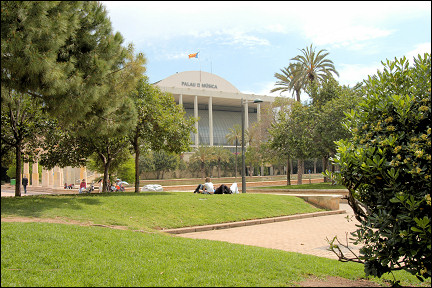
|
We pass the "music palace" Palau de la Música, walking between majestic palmtrees. We also pass Gullivers Park, a recreational park and playground for children.
Finally we arrive at the Ciudad de las Artes y las Ciencias. What strikes me is the amount of light and space. The large futuristic buildings of steel and glass are enormous and built in the water, some look like big spaceships.
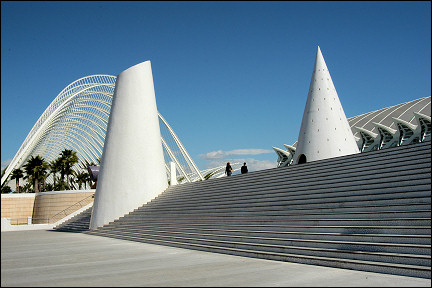
|
Palau de les Arts Reina Sofía is an avant-garde center with opera, dance and theater performances. We walk underneath a steel arch on L'Umbracle, a promenade with subtropical plants, which functions as entrance and is built on top of an underground parking garage.
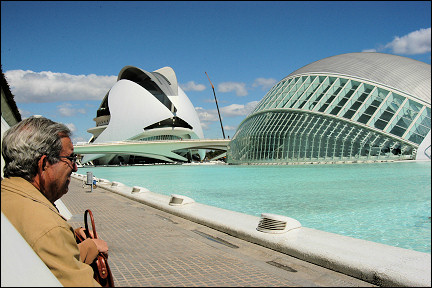
|
L'Hemisfèric is a building that looks like a big human eye. It houses a planetarium, a laserium and an Imax movie theater.
Next to it is the Museo de las Ciencias Príncipe Felipe, the largest science museum in Spain.
Science, nature and art, with over a thousand interactive modules and spectacular experiments. Everywhere are signs that read "prohibido no tocar", "it is forbidden not to touch the exhibits". Visitors are encouraged to actively participate in scientific and technological experiments.
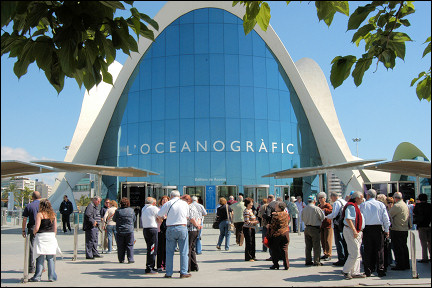
|
We go to the entrance of L'Oceanográfic, Europe's largest aquarium. In large tanks with millions of liters of water life in the worldseas is recreated.
Thousands of fish and sea mammals live in these tanks and can be watched from all sides. Unfortunately, one day is not enough to see everything.
By the evening we return to the old city center. On Plaza de la Virgen, Valencian artists show their work.
City beaches Las Arenas and Malvarrosa
Costa de Valencia is at walking distance from the city center
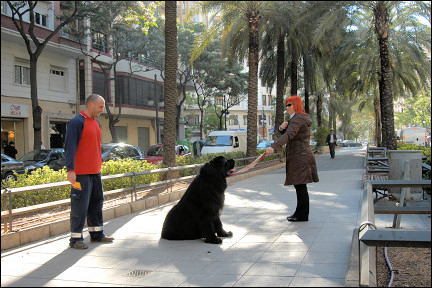
|
Next morning the weather is perfect for a long walking tour. We walk between the arena and the train station to the arrow-straight Avinguda Antiguo Reino de Valencia, a busy shopping street with many traffic lights and tall buildings. Cars are parked everywhere.
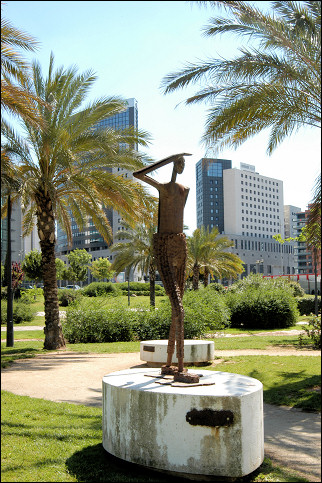
|
We walk in the shadow of the palmtrees, on the pavement between the two roadsides and arrive at Turia Park.
There are pre-technological sculptures on concrete pedestals. A little farther we see residential high rises and a branch of Spain's best-known department store El Corte Inglés.
Along the former river we continue eastward and arrive in the Grau district. By now, it's 28 degrees Centigrade and, according to our map, we are close to the sea.
We follow Calle Doctor Juan José Domine which also has seperated roadsides. Between them is a footpath with bizarrely shaped trees and benches. In one of the eateries we order bocadillos de jamon, ham sandwiches.
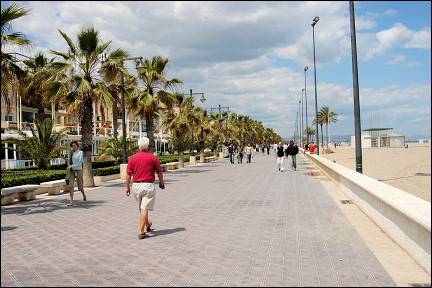
|
Playa de Las Arenas has a clean, wide sandy beach and a promenade with a row of beautiful fan palms, restaurants and outdoor cafés. On the beach sand artists are building funny shapes.
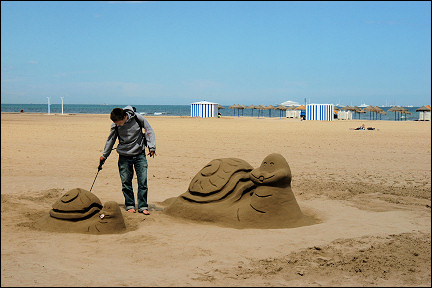
|
Everywhere in Valencia we see flowers, but nowhere as lush as on Playa de la Malvarrosa. There are thousands of yellow and pink little stars on woody stalks. They are ground covering iceplants, succulents, which were planted to keep the sand from being blown away.
We pass a fountain in the shape of a boat.
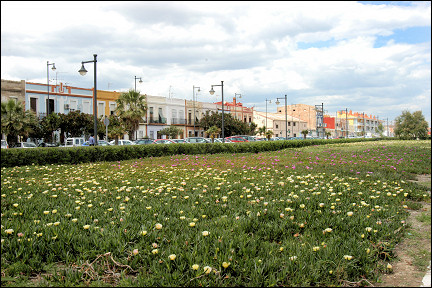
|
A few hours later the temperature has dropped, colors become warmer and make everything even more beautiful and atmospheric. Restaurants lure customers with fresh fish and Valencian specialties like paella and other rice dishes.
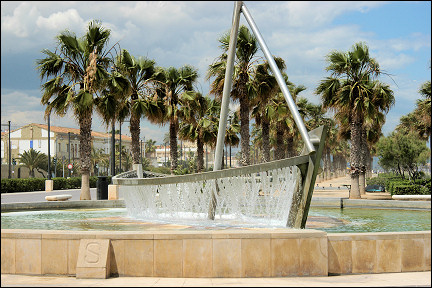
|
After we have enjoyed a delicious meal of fish, a glass of wine and the view of the sea, we walk to the end of the promenade, where La Parada del Autobuses is; we take a bus which brings us directly to Plaza del Ayuntamiento in the old city center.
It's late and the city center is completely different now that Valencia's nightlife is in full swing. On Plaza de la Virgen a stage has been built against the basilica. The square is covered with wooden folding chairs. We sit down and enjoy the music, the atmosphere and the people around us.
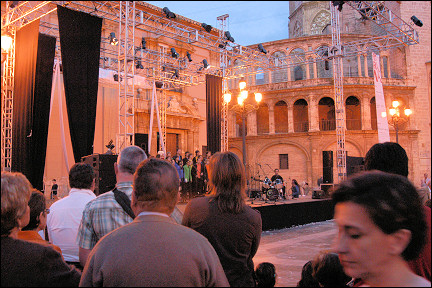
|
Later, on Plaza de la Reina and in the El Carmen district, it's very crowded. ¡Hola! ¿qué tal?, we hear everywhere. We're fine, thanks, but after a few glasses of Agua de Valencia, a mix of orange juice, Spanish wine and liqueur, we return to our hotel.
Mercado Central and Tribunal de las Aguas
900 stalls at the largest indoor market in Europe
After a hearty breakfast we go out to explore again; the sun shines in a bright- blue sky. We feel great. Today we visit the water court.
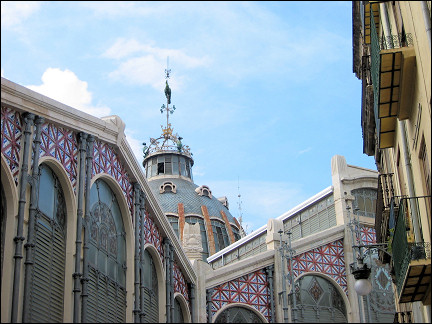
|
We cross the busy Calle San Vincente Martir and via Avenida de Maria Cristina we arrive at the largest indoor market in Europe, Mercado Central, with over 900 stalls, in an Art Nouveau building, dating from 1920, with stained-glass windows, cast iron and mosaic tiles.
On top of the dome is a curious windvane, La Cotorra del Mercat: a green parrot symbolizes the pleasant bustle of the market building, according to my brochure.
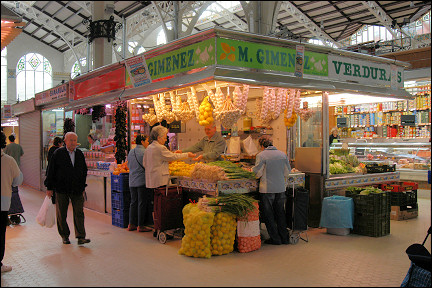
|
By the entrance are shops with paella pans with diameters of almost a meter. Inside Mercado Central, large bunches of Chile peppers hang in strings on stalls. There are fresh yucca roots, artichokes, eggplants and citrus fruit available in large quantities.
In a seperate hall there are glass cases with fish and crustaceans on ice. There is saffron, fresh garlic, capers, you name it and it's here.
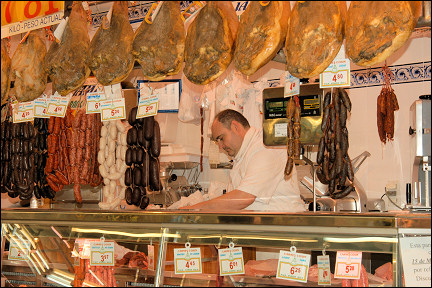
|
The butcher calls from under his sturdy hams, which hang from the ceiling, ¡alto ahi! and makes a stop sign with his hand when he sees I want to take a picture. He turns some buttons in the electricity case on the wall and suddenly all lights in his small butcher store come on.
He smiles at me and calls: ¡más luz! ¡más bonito! and continues with his work.
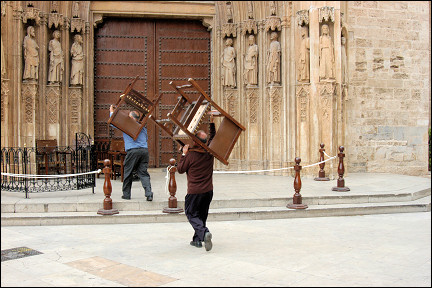
|
Opposite the Mercado Central sits Lonja de La Seda, the silk hall, a famous Gothic construction. In the past, it was an exchange where silk was bought and sold. Unesco put the building on the World Heritage list. From 11 AM, the building is open to the public.
We walk to the Apostle Gate, where the water court spectacle is about to begin. Leather seats with the names of the irrigation canals on them are carried by strong men, above their heads, to the gate and put down in a circle in an area enclosed by a rope. I read names like Çequia de Mislata, Çequia de Benàger i Faitanar and Çequia de Quart. They are the same names we saw on the goddesses in the fountain.
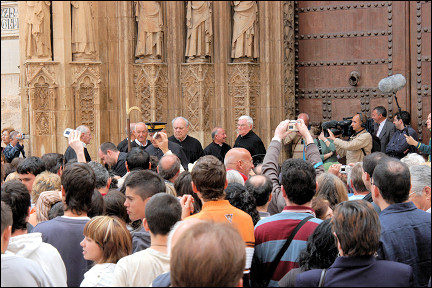
|
El Tribunal de las Aguas consists of eight men who each represent one of the main canals which supply water for the agricultural area around Valencia. They meet every Thursday at noon in front of the Apostle Gate on Plaza de la Virgen.
Farmers from the huerta take their conflicts to this court and users of the irrigation canals bring their complaints. Whoever cheats of lies, is cut off from the water suppply. The verdict cannot be appealed, even though it is only verbal.
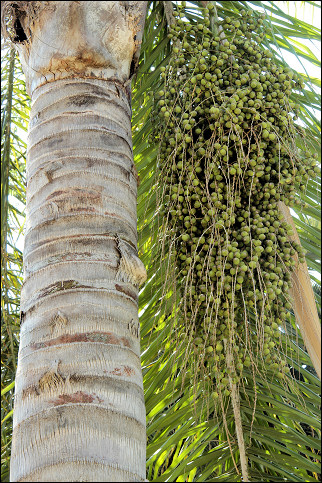
|
Meanwhile, the square is filled to the rim with hundreds of people, there even is a camera crew to witness the verdict. Here is the president of the court, completely dressed in black and holding a cane with a sharp point and a gold-colored hook; around his black cap is a gold-colored ribbon with the emblem of the water court.
Seven men, also dressed in black, follow him and sit down on the seats in front of the Apostle Gate. To make a long story short: this week there are no complaints. All in all the whole thing takes less than ten minutes, but the men get a great round of applause. The seats are removed and everyone is their way again.
We also leave the square and walk to the Puente del Real. We cross the bridge to the other side and are at the entrance of the Jardines del Real, also called Viveros Municipales.
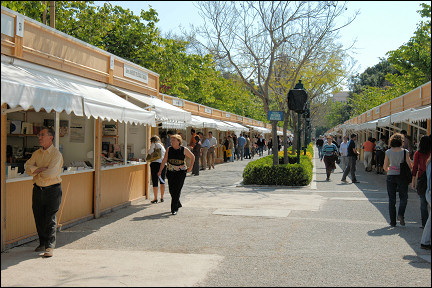
|
It's crowded in the municipal garden. There's a wide, open strip with on both sides wooden stalls with books. Beautiful books of hours with illuminated letters, every page of these books looks like a miniature painting. There are manuscripts with Roman and Gothic decorations and other religious books.
In a nearby aviary all kinds of tropical birds fly from branch to branch; on the ground quails rummage about, looking for food.
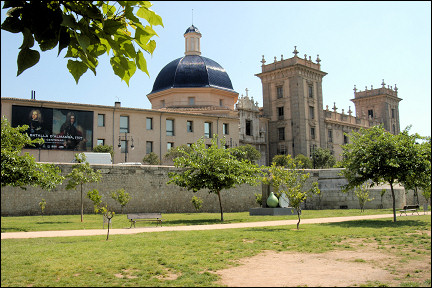
|
We walk on wide, neatly raked gravel paths between flowerbeds and sculptures; we see a date palm laden with dates. From the exit we walk via a tunnel underneath the busy San Pío V and find ourselves in the Turia Park again.
To our right is the Museo de Belles Artes. The soccer fields in Turia Park are all in use.
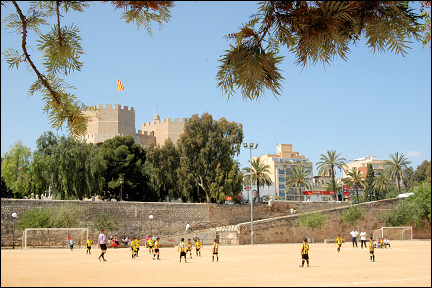
|
At the Puente de Serranos we leave the "river" and enter the old city center through the city gate. The Torres de Serranos is the largest Gothic city gate in Europe. It was built in the 14th century by Pere Balaguer.
Until 1887 the towers on the north side were used as a prison for the nobility.
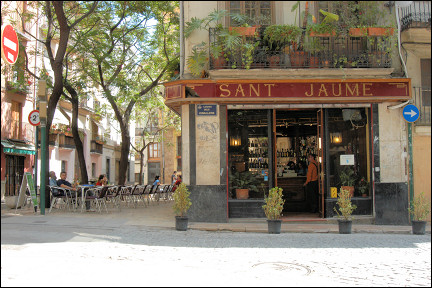
|
Under the trees we sit down on the Sant Jaume terrace to enjoy a nice, ice-cold beer and a plate of marinated aceitunas de la casa, house olives. A red city bus pushes itself through the narrow streets along the terrace. Nobody minds, it's part of the scenery.
After an hour we continue our tour. In one of the narrow streets there are colored flower pots on balconies with gorgeous azulejos. A woman in an open doorway approaches me. Inside, on a table, lie beautiful, hand-made toys, very simple and pretty. An elderly man makes them.
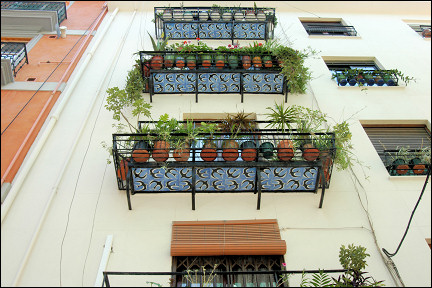
|
We are getting tired of wandering the many streets and squares and return to Plaza del Ayuntamiento where we sit down for a couple of hours and enjoy the sunset and everything around us, together with the Valencians.
Jardin Botánico
Gorgeous orchids are grown in the greenhouses
Next day our tour begins on Plaza de Santa Catalina. On the terrace of Horchatería El Siglo we order a horchata, made of chufas, earthalmonds. The popular almond drink can also be bought from carts which are found in several places in the city. The Catalan word for the drink is orxata.
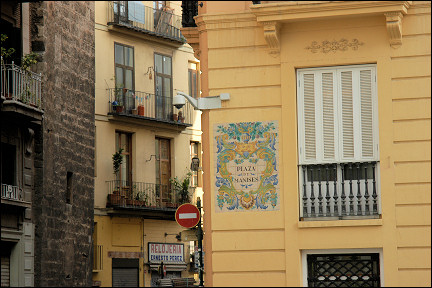
|
Via Plaza de la Virgen we reach the back of the cathedral and the basilica on Plaza de la Almoina. Ten containers with bright-red callistemon, or bottlebrush, adorn the square. On the wall of the basilica is a tile tableau of the Señora de los Desamparados.
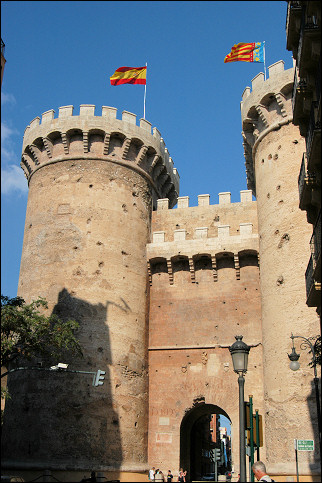
|
We decide to walk to the Torres de Quart. Via Plaza de Manises we arrive on Calle de Caballeros. Here are some wonderful palaces and pretty mansions. On one of the towers of Quart it reads Monumento Histórico Artístico Nacional: the building is landmarked as national cultural heritage. The back is completely restored.
We cross underneath the towers and follow Calle de Quart. A little later we are in front of the Jardin Botánico, the botanical garden of the University of Valencia, which has many native and exotic plants and trees.
The visitor is almost automatically led to the orchids greenhouse. I am very impressed with the many exquisite orchids that are grown in the greenhouses.
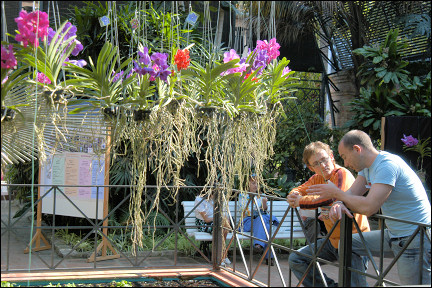
|
At the back of the garden are containers with food for the many stray cats that live in the university garden. At the exit I see that the front part of the building has no roof. A tree, which grows inside, thus has room to keep growing.
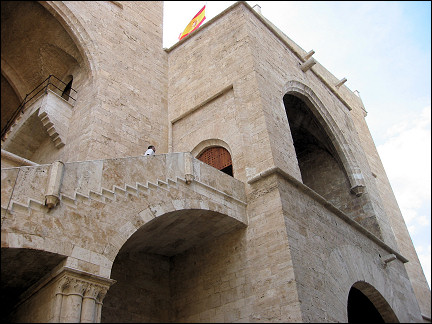
|
We return to Plaza de la Reina, to the terrace of chocolatería Valor. We can't leave Valencia without the Spanish tradition of dipping churros, deep-fried dough stalks, in melted chocolate before eating them.
On our last evening we sit on our cast-iron balcony with a view of Plaza del Ayuntamiento. ¡Valencia, adíos!